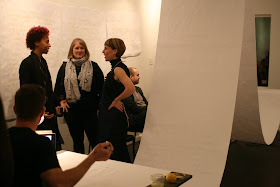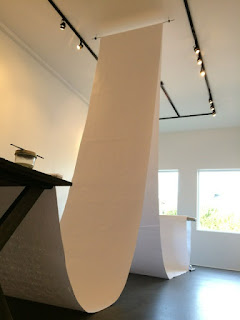Published
in The News Tribune, Jan. 13, 2017
 |
(L
to R Clockwise) JAKE ATWOOD (Brad), TONY WILLIAMS (Rocky), BRANDON
"BUNNIE" EHRENHEIM (Frank), WINNIE BEAN (Columbia), JENNA McRILL (Janet)
from the Lakewood Playhouse Production of "THE ROCKY HORROR SHOW" photo by Tim Johnson
|
“The Rocky Horror Show” has lost none of its
edge or raucous high spirits since it became an international sensation 40
years ago with young people showing up at midnight showings of the film version
in drag, wearing leather and fishnet stockings, shouting lines back at the
audience, and throwing things at the stage. What’s different in the Lakewood
Playhouse performance is that the audience is a mixture of excited young people
and older folks reliving the fun of “The Rocky Horror Show” that has never
ceased.
Playhouse Managing Artistic Director John Munn, who plays
the narrator in the show, encourages audience members to shout back, but not
throw things at the actors, and the audience the night I attended gleefully
complied. They shouted insults at Munn, who shouted back with improvised retorts, and they called Brad (Jake Atwood) an
idiot and Janet (Jenna McRill) a slut.
 |
GARY CHAMBERS (Riff-Raff) and BRANDON "BUNNIE" EHRENHEIM (Frank). Photo by Tim Johnson
|
The theater even sells (for $5) audience
participation goodie gags with special
items to be used during the show. Proceeds
from the sales of the goodie bags go toward the Lakewood Playhouse Annual
Friends Fund Campaign.
So what is “The Rocky Horror Show”? I would say it is a parody the 1975 film, which was so
bad it was good, but the stage musical preceded the film by two years.
The opening musical number, “Science Fiction/Double Feature,” sung with great
style and flare by LaNita Hudson as Usherette, announces the show as a parody
of bad 1950s sci-fi movies.
“Rocky Horror” is the story of
Brad and Janet, naïve innocents whose car has a flat on a dark and stormy night.
When they go to the nearby castle to use the phone, they get immersed in a
night of debauchery with Frank ‘N’ Furter (Brandon Ehrenheim), “a sweet transvestite from Transylvania,”
and his minion of “Phantoms,” and weirdos. In a takeoff on
“Frankenstein,” Frank ‘N’ Furter is building a man in his laboratory.
The play is a celebration of uninhibited sex. It
pushes the limits of acceptable on-stage sexuality to the edge. Most of all it
is funny, campy, and filled with great rock and roll music.
Ehrenheim is an imposing figure in his black
underwear and stockings. It helps that he is over seven feet tall even without
the platform shoes. And he sings beautifully.
Atwood is amazing in the way he transforms from
a nerdy idiot (the audience calls him out rightly) to a wild sex fiend. McRill
undergoes a similar transformation, giving credence to the audience’s labeling
her as a slut. Both Brad and Janet spend most of the second act dressed in
nothing but white underwear.
Xander Layden rocks the house as Eddie in the
wildest rock song in the show, "Hot
Patootie," and later – outstanding actor that he is – he appears with a
radically different voice and appearance as Dr. Scott, whom the audience keeps
calling “Great Scott.”
Tony L.
Williams, who audience might recognize as
“Gary Colman” in “Avenue Q,” is Rocky, the creature Frank ‘N’ Furter created, a muscular, handsome man
who appears in a gold lame suit that leaves little to the imagination. He has great moves and a strong voice. Seldom will
audiences see dance numbers that comically simulate sexual moves so graphically
as Rocky does with Janet and with Frank ‘N’ Furter.
Other stand-out actors are Hudson in her double
role as Usherette and Magenta, Gary Chambers as Riff-Raff, and Winnie Bean as
Columbia.
The band, No Picnic, is great. They’re led by keyboardist Josh Zimmerman and
driven by the hard rhythms laid down by dummer
Tai Taitano.
Finally, I can’t praise Kayla Crawford’s
choreography enough, and kudos to set designer Erin Manza Chanfrau and costume designer Diane Runkel.
I highly recommend “The Rocky Horror Show”
unless you’re easily offended by overt sexuality.
WHEN: 7 p.m. Friday-Saturday, 2 p.m. Sunday, midnight
shows Jan. 20 and 27, through Jan. 29
WHERE:
Lakewood Playhouse, Lakewood Towne Center, 5729
Lakewood Towne Center Blvd., Lakewood
TICKETS: $30 adults, $27,
Seniors (65+), $28 Military$22 students and educators, pay what you can Jan. 19
INFORMATION: 253-588-0042, http://www.lakewoodplayhouse.org/























